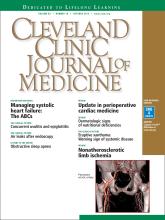TO THE EDITOR: Thanks for the concise review of obstructive sleep apnea (OSA) in the January 2016 issue.1 I offer the following comments and questions:
Risk factors for OSA include large neck circumference, which in Table 1 is defined as larger than 40 cm (15.75 inches), which would include shirt collar sizes 16 and above. In the second paragraph of the text, large neck circumference is defined as greater than 17 inches in men, which would include collar sizes above 17. The definition of a large neck as larger than 40 cm must obviously be more sensitive for predicting OSA, and the definition of greater than 17 inches more specific. Which do the authors use in clinical practice?
The American Academy of Sleep Medicine is quoted as recommending home OSA screening “if direct monitoring of the response to non-[continuous positive airway pressure] treatments for sleep apnea is needed.”2 However, the need for direct monitoring would seem to be a contraindication to home testing rather than an indication. If this statement is correct as written, would the authors explain why and how specific non-CPAP treatments for OSA are more amenable to monitoring at home than in the sleep lab?
Patients with Parkinson disease are at risk for both OSA and hypotension, making them generally an exception to the association of OSA with hypertension.3
The home overnight OSA test often consists of a pulse oximeter worn for 8 hours at night, taped to a finger.4 This simple, inexpensive test for OSA detects episodes of apnea or hypopnea that result in arterial desaturation. Is it beneficial to also document episodes of apnea or hypopnea that do not result in arterial desaturation? These episodes are included in the 17% false-negative rate for home OSA testing mentioned in the text. Are these episodes important clinically, other than for prognosis in patients who may go on to develop apneic episodes severe enough to cause desaturation?
Lastly, the authors may wish to comment on the importance of diagnosing and treating OSA in patients who plan to have elective surgery under general anesthesia, which can lead to profound sleep apnea in the recovery room, with associated morbidity and death.5
- Copyright © 2016 The Cleveland Clinic Foundation. All Rights Reserved.






